
Cognitive behavioral therapy (CBT) is a psycho-social intervention that aims to reduce symptoms of various mental health conditions, primarily depression and anxiety disorders. Cognitive behavioral therapy is one of the most effective means of treatment for substance abuse and co-occurring mental health disorders. CBT focuses on challenging and changing cognitive distortions and their associated behaviors to improve emotional regulation and develop personal coping strategies that target solving current problems. Though it was originally designed to treat depression, its uses have been expanded to include many issues and the treatment of many mental health conditions, including anxiety, substance use disorders, marital problems, ADHD, and eating disorders. CBT includes a number of cognitive or behavioral psychotherapies that treat defined psychopathologies using evidence-based techniques and strategies.
Hypnotherapy, also known as hypnotic medicine, is a use of hypnosis in psychotherapy. Hypnotherapy is viewed as a helpful adjunct therapy by proponents, having additive effects when treating psychological disorders, such as depression, anxiety, eating disorders, sleep disorders, compulsive gambling, phobias and post-traumatic stress, along with cognitive therapies. The effectiveness of hypnotherapy is not adequately supported by scientific evidence, and due to the lack of evidence indicating any level of efficiency, it is regarded as a type of alternative medicine by reputable medical organisations such as the National Health Service.
An eating disorder is a mental disorder defined by abnormal eating behaviors that adversely affect a person's physical or mental health. Types of eating disorders include binge eating disorder, where the patient eats a large amount in a short period of time; anorexia nervosa, where the person has an intense fear of gaining weight and restricts food or overexercises to manage this fear; bulimia nervosa, where individuals eat a large quantity (binging) then try to rid themselves of the food (purging); pica, where the patient eats non-food items; rumination syndrome, where the patient regurgitates undigested or minimally digested food; avoidant/restrictive food intake disorder (ARFID), where people have a reduced or selective food intake due to some psychological reasons; and a group of other specified feeding or eating disorders. Anxiety disorders, depression and substance abuse are common among people with eating disorders. These disorders do not include obesity. People often experience comorbidity between an eating disorder and OCD. It is estimated 20–60% of patients with an ED have a history of OCD.

Anxiety disorders are a cluster of mental disorders characterized by significant and uncontrollable feelings of anxiety and fear such that a person's social, occupational, and personal functions are significantly impaired. Anxiety may cause physical and cognitive symptoms, such as restlessness, irritability, easy fatigue, difficulty concentrating, increased heart rate, chest pain, abdominal pain, and a variety of other symptoms that may vary based on the individual.

Bulimia nervosa, also known as simply bulimia, is an eating disorder characterized by binge eating followed by purging or fasting, and excessive concern with body shape and weight. This activity aims to expel the body of calories eaten from the binging phase of the process. Binge eating refers to eating a large amount of food in a short amount of time. Purging refers to the attempts to get rid of the food consumed. This may be done by vomiting or taking laxatives.
Binge eating is a pattern of disordered eating which consists of episodes of uncontrollable eating. It is a common symptom of eating disorders such as binge eating disorder and bulimia nervosa. During such binges, a person rapidly consumes an excessive quantity of food. A diagnosis of binge eating is associated with feelings of loss of control. Binge eating disorder is also linked with being overweight and obesity.

Aaron Temkin Beck was an American psychiatrist who was a professor in the department of psychiatry at the University of Pennsylvania. He is regarded as the father of cognitive therapy and cognitive behavioral therapy (CBT). His pioneering methods are widely used in the treatment of clinical depression and various anxiety disorders. Beck also developed self-report measures for depression and anxiety, notably the Beck Depression Inventory (BDI), which became one of the most widely used instruments for measuring the severity of depression. In 1994 he and his daughter, psychologist Judith S. Beck, founded the nonprofit Beck Institute for Cognitive Behavior Therapy, which provides CBT treatment and training, as well as research. Beck served as President Emeritus of the organization up until his death.

Perfectionism, in psychology, is a broad personality trait characterized by a person's concern with striving for flawlessness and perfection and is accompanied by critical self-evaluations and concerns regarding others' evaluations. It is best conceptualized as a multidimensional and multilayered personality characteristic, and initially some psychologists thought that there were many positive and negative aspects.
Behaviour therapy or behavioural psychotherapy is a broad term referring to clinical psychotherapy that uses techniques derived from behaviourism and/or cognitive psychology. It looks at specific, learned behaviours and how the environment, or other people's mental states, influences those behaviours, and consists of techniques based on behaviorism's theory of learning: respondent or operant conditioning. Behaviourists who practice these techniques are either behaviour analysts or cognitive-behavioural therapists. They tend to look for treatment outcomes that are objectively measurable. Behaviour therapy does not involve one specific method, but it has a wide range of techniques that can be used to treat a person's psychological problems.
The Dodo bird verdict is a controversial topic in psychotherapy, referring to the claim that all empirically validated psychotherapies, regardless of their specific components, produce equivalent outcomes. It is named after the Dodo character in Alice in Wonderland. The conjecture was introduced by Saul Rosenzweig in 1936, drawing on imagery from Lewis Carroll's novel Alice's Adventures in Wonderland, but only came into prominence with the emergence of new research evidence in the 1970s.
Acceptance and commitment therapy is a form of psychotherapy, as well as a branch of clinical behavior analysis. It is an empirically based psychological intervention that uses acceptance and mindfulness strategies along with commitment and behavior-change strategies to increase psychological flexibility.

In applied psychology, interventions are actions performed to bring about change in people. A wide range of intervention strategies exist and they are directed towards various types of issues. Most generally, it means any activities used to modify behavior, emotional state, or feelings. Psychological interventions have many different applications and the most common use is for the treatment of mental disorders, most commonly using psychotherapy. The ultimate goal behind these interventions is not only to alleviate symptoms but also to target the root cause of mental disorders.
Cognitive therapy (CT) is a type of psychotherapy developed by American psychiatrist Aaron T. Beck. CT is one therapeutic approach within the larger group of cognitive behavioral therapies (CBT) and was first expounded by Beck in the 1960s. Cognitive therapy is based on the cognitive model, which states that thoughts, feelings and behavior are all connected, and that individuals can move toward overcoming difficulties and meeting their goals by identifying and changing unhelpful or inaccurate thinking, problematic behavior, and distressing emotional responses. This involves the individual working with the therapist to develop skills for testing and changing beliefs, identifying distorted thinking, relating to others in different ways, and changing behaviors. A cognitive case conceptualization is developed by the cognitive therapist as a guide to understand the individual's internal reality, select appropriate interventions and identify areas of distress.
Exposure therapy is a technique in behavior therapy to treat anxiety disorders.
Cognitive behavioral therapy (CBT) is derived from both the cognitive and behavioral schools of psychology and focuses on the alteration of thoughts and actions with the goal of treating various disorders. The cognitive behavioral treatment of eating disorders emphasizes on the minimization of negative thoughts about body image and the act of eating, and attempts to alter negative and harmful behaviors that are involved in and perpetuate eating disorders. It also encourages the ability to tolerate negative thoughts and feelings as well as the ability to think about food and body perception in a multi-dimensional way. The emphasis is not only placed on altering cognition, but also on tangible practices like making goals and being rewarded for meeting those goals. CBT is a "time-limited and focused approach" which means that it is important for the patients of this type of therapy to have particular issues that they want to address when they begin treatment. CBT has also proven to be one of the most effective treatments for eating disorders.
Cognitive emotional behavioral therapy (CEBT) is an extended version of cognitive behavioral therapy (CBT) aimed at helping individuals to evaluate the basis of their emotional distress and thus reduce the need for associated dysfunctional coping behaviors. This psychotherapeutic intervention draws on a range of models and techniques including dialectical behavior therapy (DBT), mindfulness meditation, acceptance and commitment therapy (ACT), and experiential exercises.
Metacognitive therapy (MCT) is a psychotherapy focused on modifying metacognitive beliefs that perpetuate states of worry, rumination and attention fixation. It was created by Adrian Wells based on an information processing model by Wells and Gerald Matthews. It is supported by scientific evidence from a large number of studies.
Homework in psychotherapy is sometimes assigned to patients as part of their treatment. In this context, homework assignments are introduced to practice skills taught in therapy, encourage patients to apply the skills they learned in therapy to real life situations, and to improve on specific problems encountered in treatment. For example, a patient with deficits in social skills may learn and rehearse proper social skills in one treatment session, then be asked to complete homework assignments before the next session that apply those newly learned skills.
David Mikael William Veale is a British psychiatrist. He is a visiting professor in cognitive behavioural psychotherapies at the Institute of Psychiatry, Psychology and Neuroscience, King's College London and a consultant psychiatrist at the South London and Maudsley NHS Foundation Trust. He has conducted a range of clinical research, especially in body dysmorphic disorder, obsessive–compulsive disorder, emetophobia, and depression.






